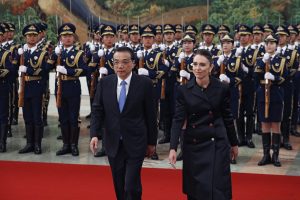In February 2018, New Zealand Foreign Minister Winston Peters quipped to the New Zealand Parliament that “the art of diplomacy is to jump into troubled waters without making a splash.” Since 2017, the New Zealand government has attempted to make a calculated correction in its relationship with the People’s Republic of China (PRC), without any deterioration in New Zealand’s overall relationship with the great power.
In the last three years, New Zealand, once merely famous for its scenery, has become infamous as the Five Eyes nation with a particularly bad case of Chinese Communist Party (CCP) political interference activities. New Zealand is characterized as the “soft underbelly” of the Five Eyes or the weakest link. A January 2020 Financial Times article asserted that New Zealand is “on the edge of viability as a member” of its allied relationships, because of its “supine” attitude to China and its “compromised political system.” The New Zealand government has been accused of lacking the “political will” to tackle the CCP’s harmful activities in the country. New Zealand’s response to handling problems in the China relationship has also frequently been compared unfavorably to Australia’s. New Zealand has been criticized for a perceived reluctance to join with other states to speak up on matters of concern with China.
New Zealand is the canary in the coalmine for many other small states seeking to find a safe way to deal with China’s increased political interference activities and aggressive foreign policy. In some ways, the actions of the New Zealand Coalition government to deal with the China problem may have gone further than what most of their Five Eyes partners or indeed comparable small state democracies have yet achieved. They have not shouted about what they were doing and it did not happen overnight – and many areas of concern have still not been dealt with.
New Zealand is practicing deliberate ambiguity in its China policy, and so far, it seems to be getting away with it: diving into the water with no perceptible splash, as Peters would put it.
The New Zealand government has strenuously avoided confronting China directly. Instead, since coming to power in 2017, the Labor-New Zealand First-Greens Coalition government has carefully managed a case-by-case recalibration of the New Zealand-China relationship, all the while claiming any changes were “country agnostic.” Unlike the prime ministers of Australia and the U.K., New Zealand Prime Minister Jacinda Ardern avoided New Zealand’s China risk-mitigation policies being associated with herself, or any one minister. Each new policy initiative has been debated publicly and then, if approved, backed up with legislation. As with the previous National-led government, any policy decisions that affected China, such as the ban on further near-space launches “without permission” (in 2016 a PLA-associated company conducted a near-space launch from a New Zealand beef farm) or the ban on Huawei in 5G, were described as following a proper process, responding to legislative requirements. The COVID-19 pandemic has deepened this quiet recalibration, and affirmed the position of those within the New Zealand national security sector who had argued for it.

































